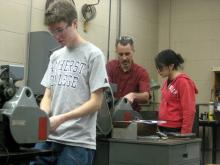The student/faculty machine shop is nothing like the typical Amherst classroom, nor like the science labs all around it in Merrill. With its massive, dusty, cast-iron drill presses and grinders and its walls plastered with safety reminders, it looks, feels, smells and sounds like an arena of sweaty manual labor. For the three weeks of Interterm, though, it has become a classroom. In “Introduction to the Machine Shop,” students are learning the basics of measuring, lathing, milling, grinding and soldering under the instruction of Robert Cann.
The course reveals the shop to be a brainy place—a room where an amazing range of disciplines unite. Originally located in the basement of Fayerweather, near the blacksmith shop, the machine shop was founded more than 80 years ago by Amherst’s physics professors, who needed a place to make their own custom equipment for experiments. Most who sign up for the class every year are physics majors (prospective or declared) who want to become certified to use the shop in case their own research requires it. But this year, there’s also an art and art history major, concentrating in sculpture, who was introduced to machining during a summer at the Rhode Island School of Design.
It turns out that Cann himself was a sculpture student, and then an industrial design student, at RISD; he also has a graduate degree in business. “But my true love is still just making stuff,” he says. So, after teaching a similar course at Hampshire, he’s taken over the title of head of the machine shop from Dan Krause. Krause has a doctorate in physics.
 Robert Cann, head of the machine shop, introduces students to the lathe. |
Just minutes into the first class meeting, other fields of study start coming into play as well. Neuroscience comes up first, in reference to a machinist who had to have an arm reattached after it was severed by a lathe. (Don’t be scared, though! Cann explains that, surprisingly, metal shops are actually far safer than wood shops. He shows us his one and only injury, “where I kinda sliced my thumb on a table saw.”)
Arithmetic and geometry are involved, of course. As they produce their first projects—large, threaded aluminum shoulder bolts—the students have to position the lathe parts at the proper angles and convert measurements between fractional inches, decimal inches and, perhaps, metric units.
Cann makes mention of economics (how globalization has led to cheaper manufacturing, which has, in turn, dramatically reduced the prices of precision measuring tools) and history (how certain innovations came about to spark and further the Industrial Revolution). We even delve a bit into the territory of women’s and gender studies: When I point out the almost comical degree of sexism in the 1950s manual from the South Bend Lathe Co., which presumes the maleness of everyone who has ever used, or will ever use, one of its lathes, Cann is inspired to do some research at home. The next day, he tells us how a Shaker woman from New York invented the circular saw and a French woman designed the band in the first band saw. (It remains true, however, that the men in the class vastly outnumber the women.)
By the middle of the second class, once they’ve taken the tour and gotten the hang of the measuring devices, the students are ready to don their safety goggles, step up to their lathes and engage in some work of mind and machine.